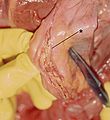Aortic dissection
Jump to navigation
Jump to search
Aortic dissection, abbreviated AoD, is an uncommon condition with a relatively high mortality.
General
Risk factors:
- Hypertension.[1]
- Atherosclerosis.[2]
- Cardiac surgery - rare, well-known complication.[3]
- In one large registry, approximately 15% of acute dissections are associated with prior cardiac surgery.[4]
Note:
May be separated into two groups:[5]
- Hypertension + atherosclerosis, typically 40-60 years old.
- Connective tissue disorders - "young".
Associations
Heritable:[6]
- Marfan's syndrome.
- Loeys-Dietz syndrome - a Marfan-like syndrome[7]
- Ehlers-Danlos syndrome.
- Bicuspid aortic valve.[2]
Others:
- Tertiary syphilis.[8]
- Turner syndrome.[9]
Classification
Two classification exist:
- DeBakey.
- Stanford.
Stanford dissection classification:[10]
- Type A - aortic root to the left subclavian artery.
- Considered a surgical emergency.
- Type B - distal to (left) subclavian artery.
- Generally, treated conservatively.
Gross
- Entry intimal tear +/- exit intimal tear.
- Blood between layers of the vessel wall.
Images
www:
Microscopic
Features:
- Defect in the tunica media (muscle layer).
- "Abundant" fresh blood in the adventitia.
- +/-Changes of cystic medial degeneration - a specific histopathologic cause of aortic dissection.
DDx:
Images
www:
Stains
- Alcian blue-PAS - no ground substance - see cystic medial degeneration.
- Elastin stain - no extensive fragmentation of the elastin fibres.
Sign out
PORTION OF AORTA, EXCISION/REPAIR: - AORTIC WALL WITH EVIDENCE OF DISSECTION. - NO SIGNIFICANT INFLAMMATION. - NO MICROORGANISMS IDENTIFIED WITH ROUTINE STAINS. - NO EVIDENCE OF CYSTIC MEDIAL DEGENERATION, SEE COMMENT. COMMENT: An elastic staining does not demonstrate fragmentation of the elastin fibres. No degenerative changes of the media are apparent with Alcian blue-PAS staining.
See also
References
- ↑ Braverman, AC. (Oct 2011). "Aortic dissection: prompt diagnosis and emergency treatment are critical.". Cleve Clin J Med 78 (10): 685-96. doi:10.3949/ccjm.78a.11053. PMID 21968475.
- ↑ 2.0 2.1 2.2 LeMaire, SA.; Russell, L. (Feb 2011). "Epidemiology of thoracic aortic dissection.". Nat Rev Cardiol 8 (2): 103-13. doi:10.1038/nrcardio.2010.187. PMID 21173794.
- ↑ Leontyev, S.; Borger, MA.; Legare, JF.; Merk, D.; Hahn, J.; Seeburger, J.; Lehmann, S.; Mohr, FW. (Mar 2012). "Iatrogenic type A aortic dissection during cardiac procedures: early and late outcome in 48 patients.". Eur J Cardiothorac Surg 41 (3): 641-6. doi:10.1093/ejcts/ezr070. PMID 22345184.
- ↑ Teman NR, Peterson MD, Russo MJ, et al. (September 2013). "Outcomes of patients presenting with acute type A aortic dissection in the setting of prior cardiac surgery: an analysis from the International Registry of Acute Aortic Dissection". Circulation 128 (11 Suppl 1): S180–5. doi:10.1161/CIRCULATIONAHA.112.000342. PMID 24030404.
- ↑ URL: http://path.upmc.edu/cases/case84/dx.html. Accessed on: 13 May 2014.
- ↑ Gleason TG (2005). "Heritable disorders predisposing to aortic dissection". Semin. Thorac. Cardiovasc. Surg. 17 (3): 274-81. doi:10.1053/j.semtcvs.2005.06.001. PMID 16253833.
- ↑ Loeys BL, Schwarze U, Holm T, et al (August 2006). "Aneurysm syndromes caused by mutations in the TGF-beta receptor". N. Engl. J. Med. 355 (8): 788-98. doi:10.1056/NEJMoa055695. PMID 16928994. http://content.nejm.org/cgi/content/full/355/8/788.
- ↑ Cruz, RP.; Marrone, LC.; Marrone, AC. (Nov 2010). "Chronic syphilitic aortic aneurysm complicated with chronic aortic dissection.". Am J Surg 200 (5): e64-6. doi:10.1016/j.amjsurg.2010.02.017. PMID 20864080.
- ↑ Carlson, M.; Silberbach, M. (2009). "Dissection of the aorta in Turner syndrome: two cases and review of 85 cases in the literature.". BMJ Case Rep 2009: bcr0620091998. doi:10.1136/bcr.06.2009.1998. PMID 21731587.
- ↑ Finkelmeier BA (September 1997). "Dissection of the aorta: a clinical update". J Vasc Nurs 15 (3): 88-93. PMID 9362838.

